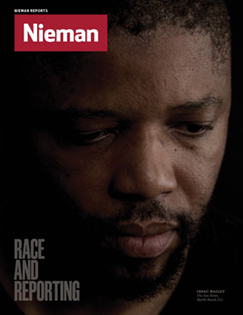
Billy Garcia enjoys an evening walk in the Bronx with his children Esmeralda and Jeremy
A report from the U.S. Department of Justice suggesting police in Ferguson, Missouri filled government coffers by targeting black people for tickets and fines. Four police officers leaving the force in Fort Lauderdale, Florida—a city with a black police chief—after they created a racially charged video and traded racist texts. A TV personality with Spanish-language Univision fired after saying first lady Michelle Obama resembled a cast member from the film “Planet of the Apes.” And the aftermath of questionable police conduct in the deaths of black people like Eric Garner of New York and Tamir Rice of Cleveland.
These are a smattering of news stories from the past year, featuring a roster of hot-button topics worthy of a call-in radio show. And this, in a way, is exactly the problem.
In my view, too often, coverage of racial issues at mainstream news organizations is treated episodically, focused largely on exploding controversies and breaking news stories. Someone is dead or is getting sued or has been arrested or has done something controversial, and media outlets are ready to track the fallout in stories almost guaranteed to rank at the top of their websites’ most-read list.
But in my experience this approach also segregates the topic of race to news, focused on conflict and controversy, that polarizes audiences. Audiences are conditioned to see race as a hot-button topic only worthy of the most blockbuster stories, making it tougher for journalists to tell subtler, more complex tales. The expectation: Stories on race will always center on major conflict, which can affect how audiences react to work where race isn’t even the primary focus, but a secondary or tertiary topic.
This is something I experienced firsthand when I wrote for NPR.org about Jimmy Fallon taking over NBC’s storied late-night program “The Tonight Show” in 2014. Deep in the piece I noted how he was living the fantasy life of a millennial white guy, his coolness validated in part by hip people of color like Will Smith and backing band The Roots. Right away, a reader e-mailed to take exception, wondering why I’m always writing about race, even though 80 percent of the story had nothing to do with the topic.
Earlier this year, a different reader looked at an online roster of stories I had covered over two weeks, noting that most of the pieces had involved race. When I e-mailed that reader, I wondered why he objected to substantial coverage of race in the first place. I also wondered why he didn’t look back four more weeks and see that I hadn’t mentioned the topic much at all in that time.
Race and culture deserve a different level of coverage than most mainstream journalists now provide
It seems news consumers have been so conditioned to see race as a combustible flashpoint in coverage, it is tough for some to come across even a brief mention without assuming the entire story is focused on the subject. And for others, race is a specialty topic that only deserves focus occasionally in the efforts of a reporter covering a general interest beat like television, as I do.
In an increasingly multicultural society, race and culture deserve a different level of coverage than most mainstream journalists now provide. When you watch a typical TV news broadcast, there are regular segments on the weather, sports, or the stock market, regardless of the news at hand. Audiences have accepted such coverage as a steady feature of any news product. Race, culture, and poverty deserve the same kind of regular coverage as the barometric pressure and the Dow Jones. If the weather and stock market tell us about the health of our environment and economy, then race, culture, and poverty tell us about the health of our society.
That’s why it’s difficult to understand The New York Times’s decision in early 2015 to move its reporter on the national race beat, Tanzina Vega, to a job covering courts in the Bronx with no announced plans to name a successor.
In today’s times of doing more with much less, it’s tough for beat reporters to fully cover their subjects, let alone for a newspaper to ensure full and fair coverage of a subject when no one is directly responsible for it. Certainly, a news outlet can cover race fully and broadly across the newsroom while also assigning a person to ensure regular, quality reporting. (Is it a cheap shot to note that the paper has a wine critic, but no national reporter on race?)
My own employer, NPR, drew headlines when it canceled a radio show that regularly discussed race and cultural diversity, “Tell Me More,” also eliminating 28 positions across the company. But host Michel Martin and a few of the show’s staffers were moved to the identity and culture department, the home of Code Switch, which covers race, culture, and diversity subjects.
This should be an easy call for journalism outlets. If you want to see more nuanced discussion of race in America, you have to provide more nuanced and consistent coverage first.
Which only leaves one question: Why isn’t more of this happening now?
Read about strategies for creating inclusive newsrooms in our Race and Reporting cover package



